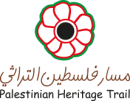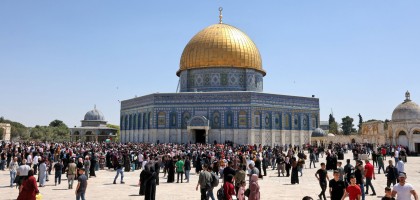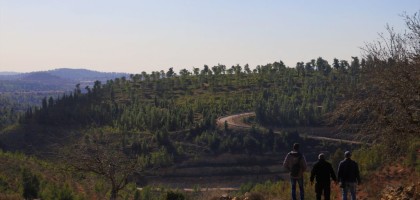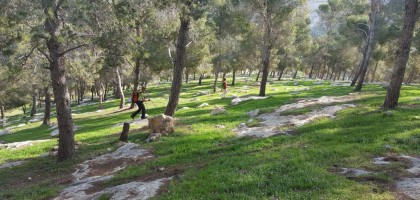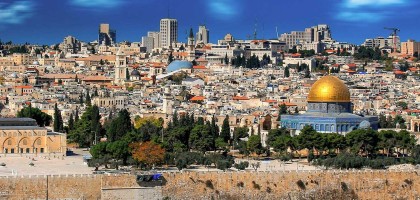The Old City Of Jerusalem - Cultural tour

The Old City of Jerusalem Cultural Tour
Points of Interests
1. Bab Ez Zahreh (Herod’s Gate): Herod’s Gate is a gate in the Northern Walls of the Old City of Jerusalem. It connects the Muslim Quarter inside of the old city to the eponymic Palestinian neighborhood of Bab Ez- Zahreh, situated just outside. It is a short distance to the East of the Damascus Gate.
2. The Indian Corner: The Indian Jerusalem tale is an engaging story replete with Indian saints and soldiers, Indian pilgrims and princes, and a Jerusalem Indian-Palestinian family Ansari that has kept an “Indian corner” alive in Jerusalem through wars, conquests, and occupation. The story of the hospice or the Indian Corner stretches through many centuries, the family’s own Jerusalem connection commenced in October 1923 when Haj Amin Al-Husayni, the Mufti of Jerusalem and president of the newly formed Supreme Muslim Council, dispatched a delegation to India. A key mission was to raise money from wealthy Muslim princes there for the Mufti’s restoration program on Al-Haram Ash-Sharif. In that dark underground chamber, it is said, Baba Farid fasted and meditated, which included hanging upside down in a dark room for forty days.
3. Burj Al-Laqlaq Social Center Society: was established in the year 1991 in the aim of providing services to the Jerusalemite community within the Old City walls, in addition to improving the social, intellectual, and physical reality for youth, children, women, and people with special needs in the old city of Jerusalem.
4. Sabil Ibrahim Al-Rumi: The Sabil was known as Sabil Al-Basiri and Sabil Bab Al-Nazir, but according to the foundation inscription, the one who renovated it was Ibrahim Al-Rumi in the Mamluk era, during the reign of Sultan Al-Ashraf Sayf Al-Din Barsbai, Egypt’s 9th Mamluk Sultan. The Sabil is built over a dome covering a large well-carved rock. The Sabil is a free-standing structure not attached to any adjacent building that caters to people who arrive from Bab Al-Nazir and Bab Al-Ghawanima.
5. African Community: People of West African origins living in the Old City of Jerusalem make up one of the most marginalized and minoritized communities in the city. In terms of their socio-economic history, they used to represent one of the largest ethnic groups in Jerusalem before the 1948 War. In the Old City, West African nationals have mostly been categorized as custodians and guardians of Holy sites and schools. However, their socio-economic profile is far more complex. They are involved in many kinds of economic activities and are settled in both the urban centers and rural villages. The peak of their migration took place during the colonial period in Africa, and most of them have now been permanently settled for over a century. They interact with other ethnic groups daily and share many common socio-economic concerns with their neighbors due to economic and political turbulence in the city.
6. Suq El-Qattanin: Is among the most famous Suqs in Jerusalem. It is adjacent to Al-Aqsa Mosque and leads to it from the Western side. It represents a vital connecting point between Al-Aqsa Mosque and Al-Wad Street. The current name, Suq Al-Qattanin, is not its original name but dates to the 15th century AD when Suq was famous for the sale of cotton and its derivatives. Sometimes, locals refer to it as the ‘Dark Suq’ due to the variance in light compared to the open parts of Al-Aqsa Mosque. It should be more rightly named after the person who built it, Prince Tankiz Al-Nasiri, the powerful Levant commissioner (737 AD).
7.Sabil Bab Al-Silsila: Sabil (Drinking water Fountain) Bab Al-Silsila dates to the Ottoman era and was built in 1536 - 37 AD as part of the water system project ordered by Sultan Suleiman Al-Qanuni (Suleiman I), which included building nine Sabils, only six of which are remaining, and constructing the water canal from the Suleiman Pools. It is a Sultanate Sabil that follows a new style of Sabils built in Jerusalem, one not used in the past. The style is simple, composed of a recessed niche wall. There is no water supply room, windows, or water well, like Ayyubid or Mamluk Sabils. The sabil’s niche has three parts: the upper is a pointed chevron arch with the knight’s rank. In the middle is an ornament which was originally a large window with an upper arch, with the inscription plaque below it. The inscription dates Sabil’s construction, mentioning Sultan Sulieman’s name, titles, and the date on which the structure was completed.
8. ‘Uthmaniyya School: The ‘Uthmaniyya School is located on the Western Wall of Al-Aqsa Mosque to the south of Bab Al-Mutawada’, between the door of Suq Al-Qattanin and the Al-Ashrafiyya school. The ‘Uthmaniyya was funded and built by Asfahan Khatun, the daughter of Prince Muhammad who was known as Khanum. Lady Asfahan generously spent time on her school, given that this school’s Waqf included the lands of the village of Kafr Qar’ and others in the lands of the Rum. The Waqf had a teacher, a Quran reader, nine students, and some Sufis.
9. Sabil Al-Khalidi: The founder who assigned this Sabil as a Waqf (religious endowment) is the pride of scholars and teachers, Muhammad San’allah Al-Khalidi, son of Khalil Al-Khalidi. The family name (Al-Khalidi), the titles of the founder and those of his father as mentioned in the Waqf document indicate clearly that Muhammad San’allah Al-Khalidi was a prominent dignitary of Jerusalem during that era. The roots of the Al-Khalidi family, as registered in the Waqf document, have a deep history into the early years of Islam and Khaled Ibn Al-Walid, the Prophet’s companion. The Khalidi family and its members had a pioneering role in the history of Jerusalem and Palestine. Many of its members assumed important, influential positions during and towards the end of the Ottoman period.
10. Al-Khalidiyyah Library: Al-Khalidiya Library, an ancient building that dates to the thirteenth century AD, is at the heart of the city of Jerusalem, one hundred meters away from Al-Aqsa Mosque in the “Bab Al Silsila” or “Chain Gate” area and overlooks Bab Al Magharbeh “Dung Gate”.
11. Mausoleum of Turkan Khatun: Turbat As-Sayida Turkan Khatun is located on the North side of Bab As-Silsila Road. According to the foundation inscription, it belonged to a woman, or khatun in Turkish, a daughter of one of the Uzbek princes. She was a descendant of one of the Islamic families that ruled the eastern Islamic world. It appears that Turkan Khatun wished to reside in the Old City, and when she died, she was buried in Jerusalem in this mausoleum which was built especially for her. There is also the possibility that Turkan Khatun passed through Jerusalem on her way to pilgrimage and decided to settle in it.
12.Khan As-Sultan: After visiting the three Suqs, at the Southern end of Suq Al- Khawajat is the start of the street to Bab AS-Silsilah. Ten meters further down, one finds the entrance to Khan As-Sultan, also known as Al-Wakala. It is attributed to the Mamluk Sultan Al-Zahir Barquq, who renovated it in 1386 AD. The Khan is composed of two floors, the lower of which was used for keeping animals and receiving goods arriving in Jerusalem from the countryside, while the upper floor included private areas used for receiving guests, normally traveling traders. The income from this Khan was earmarked for Al-Aqsa Mosque maintenance projects, amounting in the 9th Century H to about 400 gold dinars. This Khan was a center for commercial life, whereby goods were priced, taxed, and distributed to retail traders.
13. Suq Al-’Attarin: is the middle one among the three Suqs and is also the middle of Cardo Street, extending from the end of Suq Khan al-Zait until the beginning of l-Bashura. It is recommended that visitors visit this Suq in full, given its small size. Note that this Suq is relatively narrow, and fully covered with cross-vaults, with openings in the middle for light and ventilation. When the sun’s rays pass through these vents and reflect on the colorful goods exhibited in shops, they add a poetic touch to the Suq and make passing through it an enjoyment that is worth the effort.
14. Suq Aftimos and Suq Al-Dabbagha (The Tanners’ Market): was established at the beginning of the twentieth century by the Greek Orthodox Patriarchate. Today, this lively street offers various shops that sell leather products and beautiful souvenirs from Jerusalem. Traditional restaurants abound, offering rooftop dining with stunning views of the surrounding Old City.
15. The Citadel: was established at the beginning of the twentieth century by the Greek Orthodox Patriarchate. Today, this lively street offers various shops that sell leather products and beautiful souvenirs from Jerusalem. Traditional restaurants abound, offering rooftop dining with stunning views of the surrounding Old City.
16. Jaffa Gate (Bab al-Khalil): is in the western wall of the Old City, near the northwest corner of the Citadel. The gate was known as Bab Mihrab Daoud in the early Islamic period, Bab Daoud in the Franks era, and today it is called Bab al-Khalil (Hebron Gate) in Arabic and Jaffa Gate in English.
-
Topo map
-
Elevation profile
-
GPX File
